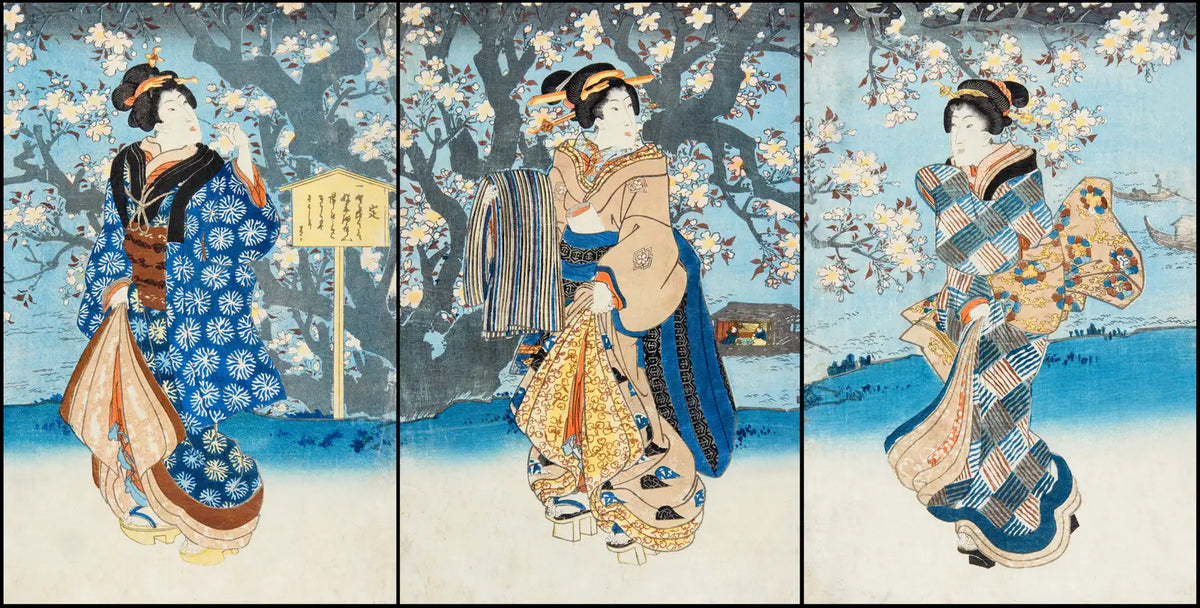

If you've fallen in love with Japanese culture, food, or travel, you're likely to find Ukiyo-e paintings utterly captivating. These vibrant and intricate artworks offer a window into Japan's rich history and society. From delicate depictions of landscapes to bold portrayals of kabuki actors, Ukiyo-e paintings capture the beauty and complexity of a bygone era. This blog post aims to take you on a visual and historical journey through the world of Ukiyo-e, highlighting its significance and allure.
The Origins and Evolution of Ukiyo-e
Ukiyo-e, which translates to "pictures of the floating world," emerged during Japan's Edo period (1603-1868). This art form became popular among the merchant class who desired affordable art that depicted their urban lifestyle. Initially focused on black-and-white prints, Ukiyo-e evolved to include vivid colors as technological advancements in printing techniques occurred.
Artists like Hishikawa Moronobu were pioneers in this field, setting the stage for more famous names like Katsushika Hokusai and Ando Hiroshige. Their works captured aspects of daily life, from bustling cityscapes to serene natural scenes. These paintings served not only as art but also as a form of social commentary, reflecting the interests and aspirations of the common people.
The popularity of Ukiyo-e can be attributed to its accessibility. Unlike other art forms confined to the elite, Ukiyo-e was mass-produced, making it possible for ordinary citizens to own art that resonated with them. Over time, this democratization of art helped Ukiyo-e become a significant cultural phenomenon.
Key Themes in Ukiyo-e Paintings
Ukiyo-e paintings are renowned for their diverse themes, each offering unique insights into Japanese culture. One prevalent theme is nature, often depicted with a profound sense of reverence. Artists captured the changing seasons, majestic mountains, and delicate cherry blossoms with exquisite detail. These nature scenes not only highlight the beauty of Japan's landscapes but also serve as metaphors for life's fleeting nature.
Another prominent theme is the portrayal of famous kabuki actors and sumo wrestlers. These subjects were immensely popular, as they allowed people to bring a piece of entertainment culture into their homes. Ukiyo-e artists captured the dynamic poses and expressions of these performers, showcasing their charisma and skill.
Additionally, tales from history and mythology frequently appeared in Ukiyo-e paintings. These stories, often dramatized with bold colors and dynamic compositions, served to educate and entertain. By bringing historical events to life, Ukiyo-e helped preserve Japan's cultural heritage.
Ukiyo-e Techniques and Styles
Creating Ukiyo-e involved complex techniques that required exceptional skill and precision. The process began with a detailed sketch, which was then transferred to wooden blocks for printing. Each color required its own block, making the alignment and carving of blocks a meticulous task. Skilled artisans worked together, with different individuals responsible for drawing, carving, and printing.
The use of vivid colors was a hallmark of Ukiyo-e. Initially limited to indigo and vermilion, artists later incorporated a broader palette, enhancing the visual impact of their work. Techniques like bokashi, which involved blending colors to create gradients, added depth and dimension to the prints.
Styles within Ukiyo-e varied, reflecting the artists' individual approaches. Hokusai, for example, was known for his dynamic compositions and bold use of colors, while Hiroshige's works often featured serene landscapes with a softer palette. The diversity of styles within Ukiyo-e contributed to its enduring appeal.
The Influence of Ukiyo-e on Western Art
Ukiyo-e paintings have had a profound influence beyond Japan's borders, particularly on Western art. During the late 19th century, Japanese art gained popularity in Europe, sparking the Japonism movement. Artists like Vincent van Gogh and Claude Monet were captivated by the simplicity and elegance of Ukiyo-e, which inspired new approaches to composition and color.
The flat perspective, bold outlines, and emphasis on natural elements found in Ukiyo-e paintings resonated with Western artists seeking to break free from traditional norms. This cross-cultural exchange enriched both Japanese and Western art, fostering a deeper appreciation for diverse artistic styles.
Today, Ukiyo-e continues to inspire artists and designers worldwide. Its timeless aesthetic and innovative techniques remain relevant, influencing modern graphic design, fashion, and even animation. The global impact of Ukiyo-e underscores its significance as a bridge between cultures.
Collecting and Preserving Ukiyo-e
For art enthusiasts and collectors, owning Ukiyo-e prints offers a tangible connection to Japan's artistic heritage. Collecting these prints involves careful consideration of their condition, rarity, and provenance. Authentic Ukiyo-e prints can vary in price, with factors such as age, artist, and edition influencing their value.
Preservation is crucial to maintaining the integrity of Ukiyo-e prints. Exposure to light, humidity, and improper handling can cause deterioration. Many collectors invest in archival framing and storage to protect their pieces. Additionally, digitization efforts by museums and galleries help ensure the preservation of Ukiyo-e for future generations.
Ukiyo-e exhibitions and auctions provide opportunities to view and acquire these artworks. Events like the Tokyo International Antiquarian Book Fair and auctions by renowned houses attract collectors and enthusiasts from around the world, fostering a sense of community among those passionate about Ukiyo-e.
Ukiyo-e in Modern Culture
While Ukiyo-e originated centuries ago, its influence permeates modern culture. Elements of Ukiyo-e can be seen in contemporary art, fashion, and design. Japanese animation and manga, for example, often draw inspiration from Ukiyo-e aesthetics, incorporating similar compositions and color schemes.
Fashion designers have also embraced Ukiyo-e motifs, incorporating them into textiles and accessories. The bold patterns and intricate details of Ukiyo-e lend themselves well to modern design, creating a fusion of traditional and contemporary styles.
Beyond visual arts, Ukiyo-e has inspired literature, music, and even video games. Its themes of nature, entertainment, and storytelling resonate with audiences across different media, demonstrating the enduring relevance of this art form in today's world.



